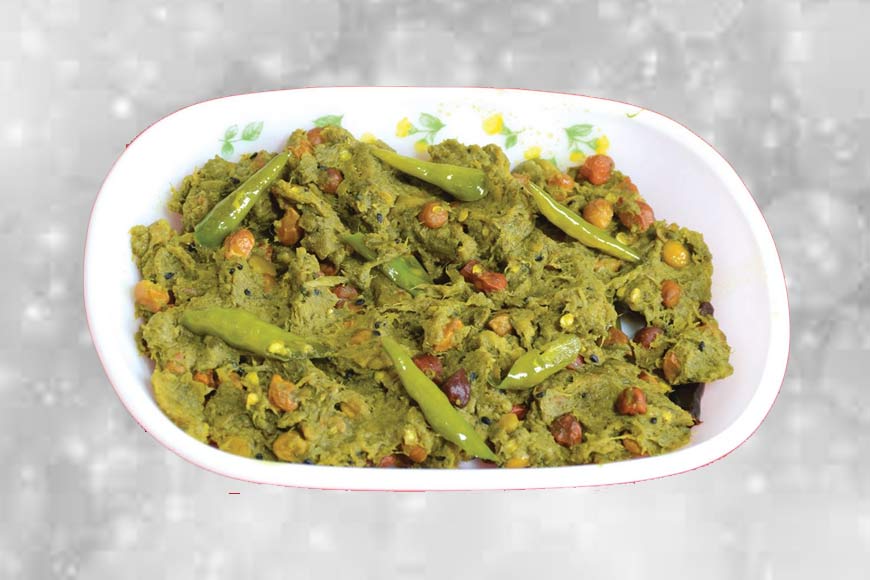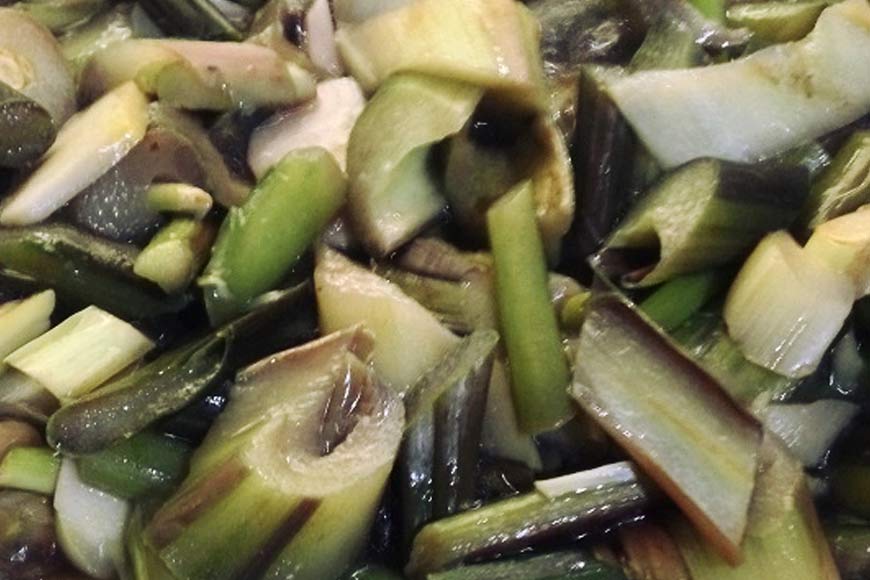The earthy and robust taste of Bengal’s favourite Kochu

Kochu or Colocasia esculenta aka taro is a tropical plant that grows in abundance sporadically, especially during the monsoons. The large-leaved tropical Asian plant (Colocasia esculenta) of the arum family has a thick, tuberous underground stem whose leaves are simple, broad, and long-petioled. Its starchy corms and cormels are edible but it is generally a very underrated vegetable that grows on its own. During monsoon when new life springs up from earth far and wide, taro plants suddenly appear from nowhere amid wild vegetations and sway and dance in the wind in gay abandon. In cities we don’t get to see burgeoning greenery but once you go to the outskirts, you will be greeted with the sight of beautiful heart-shaped taro leaves craning their necks from the thick and overgrown carpet of wild grass and greeting you cheerfully. The shiny dark green leaves are water repellent, or hydrophobic. When water drops fall on the leaf surface, they roll down, carrying dirt particles with them.
Unopened leaves and petioles are prepared like spinach and used as a vegetable, while the tubers can be steamed or boiled as a delicacy. Taro leaves are rich in minerals and vitamins, making them a good source of riboflavin, phosphorus, thiamin, zinc, and iron, and vitamin C, vitamin B6, copper, niacin, manganese, and potassium. Taro leaves are a great source of fiber and offer a variety of potential health benefits, including improved blood sugar management, gut and heart health. Taro leaves also contain polyphenols and antioxidants that may combat cancer growth and protects the body from oxidative stress. Taro corms are also very high in starch, and a good source for dietary fiber. One could just go on singing paeans about the beneficial effects of consuming taro leaves and roots but it is a pity that whenever these plants are spotted in a garden, they are uprooted and thrown away.
Colocasia esculenta plant is ingrained in our tradition and is an integral part of Durga Puja. From time immemorial, Durgotsav also marks the harvest season, a season of health, wealth and prosperity. There are many beliefs and rituals attached to this Bengali festival. Although Durga Puja runs for 10 days, the main or Maha Puja begins on the seventh day, also known as Saptami.
On the early hours of Saptami, Goddess Durga is invoked in a group of nine plants bunched together, called Nabapatrika, and tied to the twigs of white Aparajita plant with a yellow thread. Each plant represents the nine manifestations of Adi Shakti. Banana plant is Goddess Brahmani, likewise Colocasia plant is Goddess Kalika, Turmeric plant represents Goddess Durga, Jayanti plant is Goddess Kartiki, Bael leaves (stone apple or wood apple) represents Lord Shiva, Pomegranate leaves is Goddess Raktadantika, Asoka leaves is Goddess Shokarahita, Arum plant portrays Goddess Chamunda and Rice paddy represents Goddess Lakshmi.
Nabapatrika was a popular ancient ritual performed by peasants worshipping Mother Nature for rich and bountiful harvest. Nabapatrika is a symbol of fertility that epitomizes the victory of good over evil and honours the goddess as the motherly power behind all of life and creation. With Durga Puja gaining prominence, this ritual was assimilated in the festivities. Nabapatrika has no reference in the Vedas or the Puranas. The earliest reference is found in ‘Krittivasi Ramayan’, a rendition of the Ramayana in Bengali by 15th century Bengali poet Krittibas Ojha. This vital ritual of Durga Puja is an example of inclusiveness — harmonious synthesis of Vedic and ancient non-Vedic rituals.
Many scholars have even opined that the Nabapatrika is a form of Durga herself, which symbolizes all the aspects of nature in a complex vegetative state. At a time when we cry hoarse about the adverse effects of climate change and weather patterns, here is the highest form of regard for the environment where goddess Durga is symbolized by the nine indigenous plants and trees which have been worshiped as preserver of life on earth.

Maa Durga and her four children are welcomed in Bengali households every year they way a daughter comes to visit her parents from her husband’s abode. She is both a 'devi' and a daughter and her arrival calls for grand celebration. During the four days’ puja, devotees offer naivedya. In many ‘Bonedi’ (aristocrat) families, colocasia esculenta aka Kochu shaak is an essential dish offered to the goddess. Bakulia House in Watgunge has been celebrating Durgotsav at the family house for nearly two centuries. The family members strictly adhere to all the rites and rituals set down by their ancestors. On Mahashtami day, the deities are offered Maan-kochur dalna (colocasia curry) along with other items. On Mahanavami, the Goddess is offered kochu shaak (taro leaves) with other items. The offering of cooked parts of plants and various types of leaves other than traditional vegetables like kochu shaak, kochu (colocasia), thor, mocha, noteyshaak (colocasia, banana pith, banana bloom etc) are symbolical as a way of expressing gratitude to Devi Shakambhari, Goddess of vegetation.
Kochu shaak is believed to be a favourite dish of Goddess Kali and Sevayats (servitors) at Kalighat Temple serve kochu shaak to the deity at lunch every day. Most people who have kochu (colocasia) are afraid to try out kochu shak (taro leaves) mainly because the taro plant contain high levels of oxalates that can be poisonous when consumed without cooking properly. They leave terrible itchy feelings in the throat if not cooked properly.
Here is a simple ‘niramish’ (vegetarian) kochu shaak recipe:
• Very tender unopened leaves and petioles of kochu shak (taro leaves)
• 3 or four tender hog plums (pulp extract after boiling)
• One garlic (the pods roughly pounded)
• 7 to 8 green chillies (roughly pounded. You can increase or decrease the amount depending on your taste)
• 1/2 tsp turmeric powder
• 1 Dry red chilli and ¼ tsp nigella seeds (all for tempering)
• Salt (according to taste)
• Mustard oil (for frying)
METHOD:
First wash and dry the taro leaves and then mince. Boil the hog plums and extract the pulp and keep it ready. Heat wok, put oil. When the oil stops shimmering and starts smoking, put the nigella seeds and dry chilli for tampering. Next put the roughly pounded garlic pods. Keep stirring for a while and then put the diced taro leaves and the roughly pounded chillies. Mix and keep stirring. Put salt and cover the wok with a lid. As the leaves become tender and decrease in amount, put turmeric and hog plum pulp extract. Stir well and cook till all the water evaporates. Serve hot with rice.
Hog plum pairs pretty well with colocasea, drumstick leaves and bitter gourds. Besides, hog plum season starts in early July and continues to yield fruits till the end of May. So, this is the best time to get fresh, tender hog plums for the recipe. Hog plums are rich in antioxidants, which provide a range of health benefits. It is also a rich source of fibre, vitamins, iron, essential minerals. This fruit stimulates appetite, stimulates taste buds and improves digestion.











